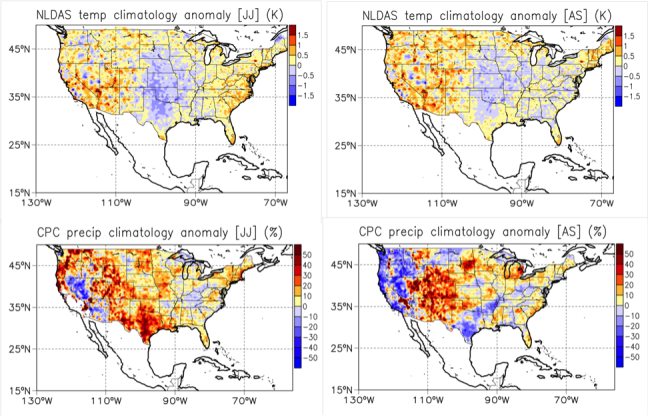The more extreme nature of US warm season climate
Arid and semi-arid regions are projected to experience the most adverse impacts of climate change; intensifying drought and precipitation extremes are found in the observational record and current global climate projections from the Intergovermental Panel on Climate Change (IPCC) report. Observational records show that anthropogenic-influenced climate change has already had a profound impact on global and U.S. warm season climate over the past 30 years, and there is increasing contrast between geographic regions that are climatologically wet and dry-the hypothesis that the ‘wet gets wetter, dry gets drier’ is seen in a new paper by Chang et al. The historic trend of extremes follows the trend of mean change for both early (June/July) and late (Aug/Sep) summer months (see figure). Temperature increases are largest in the western US, with a “warming hole” in the central US that is likely related to enhanced precipitation and evapotranspiration. Following the seasonal evolution of the precipitation climatology, increased precipitation extremes shift from the Central Great Plains in early summer to the Southwest in late summer.

Figure: Early (JJ) and late (AS) summer temperature (K) and precipitation (%) climatology difference ([1981-2010] minus [1950-1980]) from observed North American Land Data Assimilation System (top panel) and Climate Projection Center (bottom panel).
A new methodology (combined Pacific variability mode) is developed to objectively analyze how climate change may be synergistically interacting with Pacific sea surface temperature associated warm season teleconnections in North America. Regional climate simulations, driven by two “well performing” dynamically downscaled IPCC models, also shows an amplification of historical summer temperature and precipitation extremes is occurring in conjunction with the Pacific sea surface temperature influence on US regional climate. One dynamically downscaled IPCC simulation (WRF-MPI-ECHAM5) has a robust representation of Pacific sea surface temperature variability in the future projection period up to 2040, but the relationship to enhancement of precipitation extremes is not as clear as in observations. One possible assumption is that the relationship between natural variability and extreme events could be different in the future. This synergistic relationship between anthropogenic climate change and natural climate variability is critical for consideration of observed warm season climate change in the US.
The more extreme nature of U.S. warm season climate in the recent observational record and two “well-performing” dynamically downscaled CMIP3 models (Journal of Geophsycial Research-Atmospheres)
1University of Arizona
Topics
- Extreme Events
